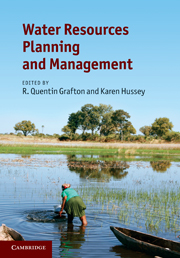Book contents
- Frontmatter
- Contents
- List of contributors
- Foreword
- Preface
- Acknowledgements
- Introduction
- Part I Understanding ‘water’
- Part II Water resources planning and management
- Part III Water resources planning and management: case studies
- III. 1 Water and waste water treatment
- III. 2 Agricultural water use
- III. 3 Urban water supply and management
- III. 4 Aquatic ecosystems
- III. 5 Industrial and mining water use
- III. 6 Rural and remote communities
- III. 7 Water infrastructure design and operation
- III. 8 Managing water across borders
- 31 Decision-making in the Murray–Darling Basin
- 32 Challenges to water cooperation in the lower Jordan River Basin
- 33 Adaptation and change in Yellow River management
- 34 Managing international river basins: successes and failures of the Mekong River Commission
- III. 9 Market mechanisms in water management
- Contributors
- Index
- References
31 - Decision-making in the Murray–Darling Basin
from III. 8 - Managing water across borders
Published online by Cambridge University Press: 05 August 2011
- Frontmatter
- Contents
- List of contributors
- Foreword
- Preface
- Acknowledgements
- Introduction
- Part I Understanding ‘water’
- Part II Water resources planning and management
- Part III Water resources planning and management: case studies
- III. 1 Water and waste water treatment
- III. 2 Agricultural water use
- III. 3 Urban water supply and management
- III. 4 Aquatic ecosystems
- III. 5 Industrial and mining water use
- III. 6 Rural and remote communities
- III. 7 Water infrastructure design and operation
- III. 8 Managing water across borders
- 31 Decision-making in the Murray–Darling Basin
- 32 Challenges to water cooperation in the lower Jordan River Basin
- 33 Adaptation and change in Yellow River management
- 34 Managing international river basins: successes and failures of the Mekong River Commission
- III. 9 Market mechanisms in water management
- Contributors
- Index
- References
Summary
Introduction
The Murray–Darling Basin, particularly in the south, is in a parlous state. Why? Drought is part of the answer, but there is widespread consensus among water policy makers, managers, researchers, and the general public that human pressures in their many forms have also played a crucial role. This is despite nearly a century of management involving five governments – the Commonwealth, New South Wales, Victoria, South Australia, and more recently Queensland – which has frequently been described as ‘world's best practice’. What went wrong? That question can lead in many directions. In this chapter the focus is on just one of them: the failure to put in place a decision-making process at the top of the institutional pyramid that could, from a basin-wide perspective, make and enforce major decisions about core issues. Significantly, the need (and the risks involved in not creating that capacity) was recognised as a key issue in each of the three major phases of institutional design and reform: first during the early decades of the twentieth century, second in the 1980s, and now with the Commonwealth Water Act 2007 and the MD Basin Plan.
The Murray–Darling Basin (MDB) is a large, complex region. It is just over a million square kilometres in size, has a diverse range of landscapes, ecosystems, land uses, and climates, includes over 30 000 wetlands, 11 of which are listed under the Ramsar Convention of Wetlands of International Importance, and produces approximately 40 percent of Australia's gross value of agriculture.
- Type
- Chapter
- Information
- Water Resources Planning and Management , pp. 673 - 685Publisher: Cambridge University PressPrint publication year: 2011

